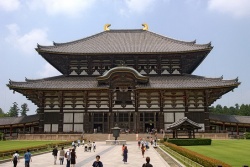Difference between revisions of "Kegon"
(Created page with "thumb|250px| Kegon (Kanji: 華厳 Hiragana: けごん) is the name of the Japanese transmission of the Huayan school of Chinese Buddhism. Huayan ...") |
|||
| (6 intermediate revisions by 2 users not shown) | |||
| Line 1: | Line 1: | ||
[[File:Daibutsu-den.jpg|thumb|250px|]] | [[File:Daibutsu-den.jpg|thumb|250px|]] | ||
| − | |||
| − | |||
| − | Over time, Kegon incorporated esoteric ritual from Shingon Buddhism, with which it shared a cordial relationship. Its practice continues to this day, and includes a few temples overseas. | + | |
| + | |||
| + | '''[[Kegon]]''' ([[Kanji]]: [[華厳]] [[Hiragana]]: けごん) is the [[name]] of the [[Japanese]] [[transmission]] of the [[Huayan school]] of [[Chinese Buddhism]]. | ||
| + | |||
| + | In {{Wiki|Chinese}}, [[Hua-yen]]. Bst. | ||
| + | |||
| + | School founded in [[China]] in the seventh century and brought to [[Japan]] by [[Dōsen]] in 736. Mother [[temple]] is [[Tōdaiji]] at [[Nara]], the largest | ||
| + | |||
| + | wooden building in the [[world]], which houses a vast figure of [[Vairocana]] (q.v.). | ||
| + | |||
| + | The [[teaching]] centres round the [[Avatamsaka Sutra]] (q.v.), ‘the culmination of {{Wiki|Chinese}} Bst. [[thought]]’ (Suzuki). | ||
| + | |||
| + | (See Jijimuge.) Although one of the smallest Bst. schools its influence has been enormous. | ||
| + | |||
| + | |||
| + | [[Huayan]] studies were founded in [[Japan]] when, in 736, the scholar-priest [[Rōben]] ([[良辯]] or [[良弁]]) originally a [[monk]] of the [[Hossō]] | ||
| + | |||
| + | [[tradition]] invited [[Shinshō]] ([[審祥]], also in [[Japanese]] [[Shinjō]], {{Wiki|Chinese}} [[Shen-hsiang]], [[Korean]] [[Simsang]]) to give lectures on the | ||
| + | |||
| + | [[Avatamsaka Sutra]] at [[Kinshōsen-ji]] ([[金鐘山寺]], also [[金鐘寺]] [[Konshu-ji]] or [[Kinshō-ji]]), the origin of later [[Tōdai-ji]]. When the construction | ||
| + | |||
| + | of [[Tōdai-ji]] was completed, [[Rōben]] entered that [[temple]] to formally [[initiate]] [[Kegon]] as a field of study in [[Japanese Buddhism]], and [[Kegon-shū]] | ||
| + | |||
| + | would become known as one of the [[Nanto Rikushū]] ([[南都六宗]]), or [[The Six Buddhist Sects of Nanto]] ({{Wiki|Nara}}). [[Rōben's]] [[disciple]] [[Jitchu]] | ||
| + | |||
| + | continued administration of [[Tōdai-ji]] and expanded its prestige through the introduction of imported [[rituals]]. [[Kegon]] [[thought]] would later be | ||
| + | |||
| + | popularized by [[Myōe]] ([[明惠]]), who combined its [[doctrines]] with those of [[Vajrayana]] and [[Gyōnen]] ([[凝然]]), and is most responsible for the | ||
| + | |||
| + | establishment of the [[Tōdai-ji]] [[lineage]] of [[Kegon]]. | ||
| + | |||
| + | Over [[time]], [[Kegon]] incorporated [[esoteric]] [[ritual]] from [[Shingon Buddhism]], with which it shared a cordial relationship. Its practice continues to | ||
| + | |||
| + | this day, and includes a few [[temples]] overseas. | ||
| + | |||
| + | |||
{{W}} | {{W}} | ||
[[Category:Buddhist Terms]] | [[Category:Buddhist Terms]] | ||
| Line 10: | Line 43: | ||
[[Category:Chinese Buddhism]] | [[Category:Chinese Buddhism]] | ||
[[Category:Mahayana]] | [[Category:Mahayana]] | ||
| + | {{JapaneseTerminology}} | ||
Latest revision as of 09:54, 23 November 2020
Kegon (Kanji: 華厳 Hiragana: けごん) is the name of the Japanese transmission of the Huayan school of Chinese Buddhism.
School founded in China in the seventh century and brought to Japan by Dōsen in 736. Mother temple is Tōdaiji at Nara, the largest
wooden building in the world, which houses a vast figure of Vairocana (q.v.).
The teaching centres round the Avatamsaka Sutra (q.v.), ‘the culmination of Chinese Bst. thought’ (Suzuki).
(See Jijimuge.) Although one of the smallest Bst. schools its influence has been enormous.
Huayan studies were founded in Japan when, in 736, the scholar-priest Rōben (良辯 or 良弁) originally a monk of the Hossō
tradition invited Shinshō (審祥, also in Japanese Shinjō, Chinese Shen-hsiang, Korean Simsang) to give lectures on the
Avatamsaka Sutra at Kinshōsen-ji (金鐘山寺, also 金鐘寺 Konshu-ji or Kinshō-ji), the origin of later Tōdai-ji. When the construction
of Tōdai-ji was completed, Rōben entered that temple to formally initiate Kegon as a field of study in Japanese Buddhism, and Kegon-shū
would become known as one of the Nanto Rikushū (南都六宗), or The Six Buddhist Sects of Nanto (Nara). Rōben's disciple Jitchu
continued administration of Tōdai-ji and expanded its prestige through the introduction of imported rituals. Kegon thought would later be
popularized by Myōe (明惠), who combined its doctrines with those of Vajrayana and Gyōnen (凝然), and is most responsible for the
establishment of the Tōdai-ji lineage of Kegon.
Over time, Kegon incorporated esoteric ritual from Shingon Buddhism, with which it shared a cordial relationship. Its practice continues to
this day, and includes a few temples overseas.
